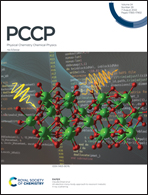Modeling of laser-pulse induced small water cluster-(H2O)N (N = 1–10) decomposition on suitable metal cluster catalysts†
Abstract
Understanding the microscopic mechanisms of electronic excitation in water clusters is a very important and challenging problem in a series of solar energy applications, such as solar water evaporation, photolysis, etc. Here we employ real time–time-dependent density functional theory (RT-TDDFT) and Ehrenfest dynamics to investigate the photodissociation dynamic process of (H2O)N=1–10 clusters and photoinduced charge transfer in them. The research presented here confirms that the plane tetramer, (H2O)4, is the most difficult one to be dissociated under laser irradiation in the ten clusters for its high (S4) symmetry; the overall order of the ease of decomposition is as follows: (H2O)6-p > (H2O)8 > (H2O)6-c > (H2O)7 > (H2O)10 > (H2O)1 > (H2O)3 > (H2O)2 > (H2O)9 > (H2O)5 > (H2O)4. Plasmon catalyst-induced water splitting is a promising and feasible way to efficiently convert solar to chemical energy via reducing the laser amplitude threshold significantly; and among the Ag6, Au6, Cu6, Al6 chains and several Cu6 clusters with Oh symmetry, the Cu6 chain seems to be the most cost-effective one. This article aims at unraveling the fundamental mechanisms and providing valuable physical insights into the behavior of water splitting to pave the way for the theoretical and experimental design of the photolysis process.



 Please wait while we load your content...
Please wait while we load your content...